Synchronization between Two Discrete-Time Networks with Mutual Couplings
Abstract
We investigate synchronization between two discrete-time networks with mutual couplings, including inner synchronization inside each network and outer synchronization between two networks. We then obtain a synchronized criterion for the inner synchronization inside each network by the method of linear matrix inequality and derive a relationship between the inner and outer synchronization. Finally, we show numerical examples to verify our theoretical analysis and discuss the effect of coupling strengths, node dynamics, and topological structures on the inner and outer synchronization. Compared to the inner synchronization inside each network, the outer synchronization between two networks is difficult to achieve.
1. Introduction
Network synchronization, as a collective behavior existing inside a network, has been widely studied since the birth of small-world and scale-free networks [1–3]. The main focus is to investigate the interplay between the complexity in the overall topology and the local dynamics of the coupled nodes [4–6]. The topological structures may be globally connected, random, small-world, and scale-free. There are many applications using the synchronization of networks [7], for instance, secure communication and multirobot coordination control. Apart from the complete synchronization appearing inside a network, there are some other types of synchronization, such as phase synchronization, generalized synchronization, lag synchronization, and cluster synchronization [8–12].
Generally, we refer to synchronization happening between two networks as outer synchronization [13], which is distinguished from inner synchronization inside a network. Compared to the inner synchronization, outer synchronization of two networks is more complex, which involves more system parameters. In 2007, Li et al. first proposed the concept of outer synchronization and applied the open-plus-closed-loop method to realize the outer synchronization between two networks with identical topologies [13]. Shortly later, using the adaptive control method, Tang et al. achieved the outer synchronization between two networks with different topological structures [14]. In [15], Wu et al. studied the generalized outer synchronization between two networks with different dimensions of node dynamics. In addition, there are many works on the outer synchronization, that is, introducing the noise, time delay, fractional order node dynamics, and unknown parameters [16–21].
In the above-mentioned works on the outer synchronization, the researchers usually applied the control methods to realize the outer synchronization and did not study the inner synchronization inside a network. In reality, the mutual coupling forms between two networks are colorful; for instance, Wu et al. investigated the outer synchronization between two networks with two active forms nonlinear signals and reciprocity [22]; however, these two coupling forms do not make the outer synchronization happen. In addition, the inner synchronization inside each network was not considered. In [23], Sorrentino and Ott provided a method to study the inner synchronization of two groups. The problem of collective behaviors inside a network and between two networks is of broad interest. For example, in subway systems, when the trains reach the platform, the outer and inner doors simultaneously open or close, showing that both inner and outer synchronization happen [24]. It is also found that present studies on the synchronization between two networks with various couplings are much less, then studying the effect of various couplings on the synchronization is interesting and meaningful.
Inspired by the above discussions, we study synchronization between two discrete-time networks with mutual couplings, including inner synchronization inside each network and outer synchronization between them. By the Lyapunov stability theory and linear matrix inequality, we obtain a synchronous theorem on the inner synchronization inside each network and a relationship between the inner and outer synchronization. Numerical simulations show that the inner synchronization is easier to achieve than the outer synchronization. In addition, given the mutual coupling matrices and appropriate node dynamics, we can adjust coupling strengths to realize the inner and outer synchronization simultaneously. In Section 2, network models and synchronization analysis are presented, and numerical examples are shown in Section 3. Finally, the discussions are included in the last section.
2. Model Presentation and Synchronization Analysis
If Lk < 0, k = 1,2, …, h, then the zero solution of (11) is asymptotically stable. Hence we obtain a synchronized theorem for networks (1).
Theorem 1. Consider network systems (1). Assume the mutual coupling matrices A = B. Let λk = αk + jβk be the eigenvalues of A, where αk, βk ∈ R. If these matrices Mk, Lk < 0, k = 1,2, …, h, then the networks (1) will achieve inner synchronization inside each network.
Remark 2. Note that Theorem 1 only gives a feasibility of the inner synchronization inside each network. When the inner synchronization inside networks X and Y happens, and the synchronized states ∥xs(t) − ys(t)∥ → 0 for a large time, then the outer synchronization between networks X and Y will be achieved.
3. Numerical Examples
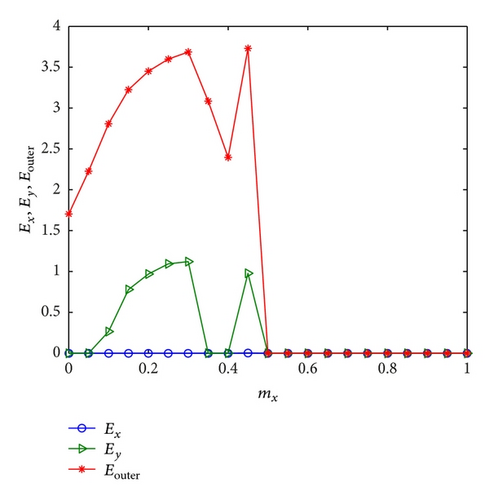
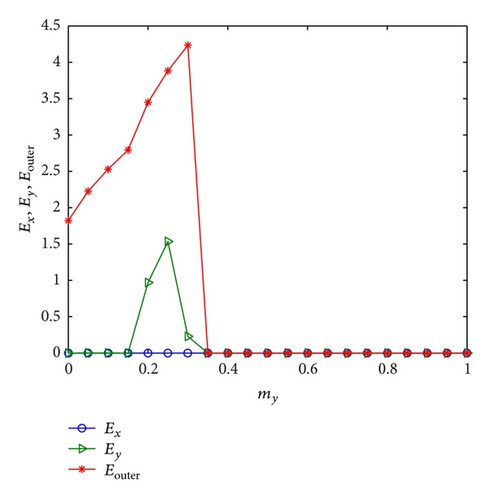
Next, we discuss the effect of node dynamics on the inner and outer synchronization and take b1 = 0.2, a2 = 0.5, and b2 = 0.3 and N = 10, mx = 0.2, and my = 0.3. We then investigate the effect of parameter a1 on the inner and outer synchronization. Similarly, given a1 = 0.3, b1 = 0.2, and a2 = 0.5 and N = 10, mx = 0.2, and my = 0.3, we study the influence of b2. The numerical simulations are summarized in Figures 3 and 4, showing that the inner synchronization inside network X always happens, while the inner synchronization inside network Y and the outer synchronization only appear for some values of a1 or b2.
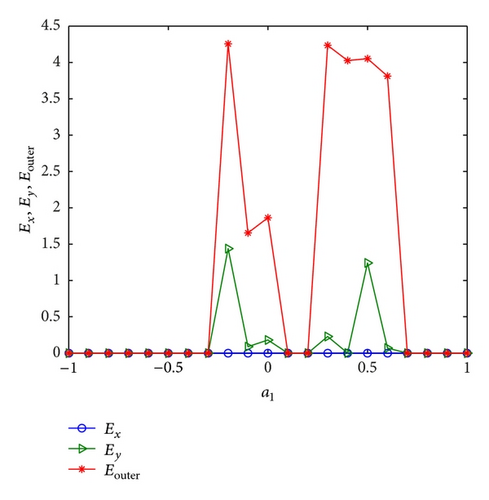
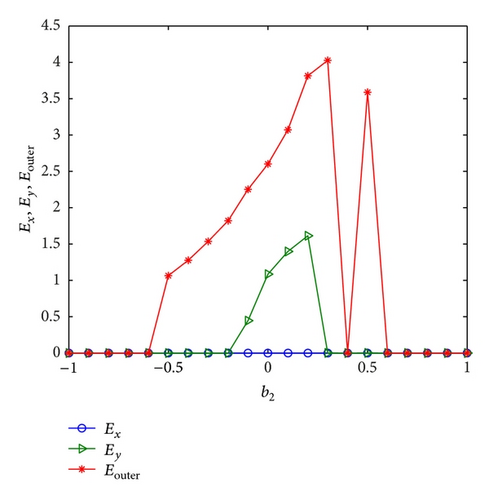
Finally, we discuss the effect of network size N on the inner and outer synchronization with aij = bij = 1/N, i, j = 1, …, N. Taking the values of a1 = 0.3, b1 = 0.2, a2 = 0.5, and b2 = 0.3 and mx = 0.2 and my = 0.3, we plot the curves of Ex, Ey, and Eouter in Figure 5. In the following, we change the topological structures of mutual coupling matrices and choose A = B as a random matrix; the numerics are shown in Figure 6. It is found that the globally connected and random topological structures have similar effect on the inner and outer synchronization. It is noted that the inner synchronization inside network X always happens. A possible reason is the effect of node dynamics. Furthermore, when the Henön map behaves chaotically, no synchronization appears.
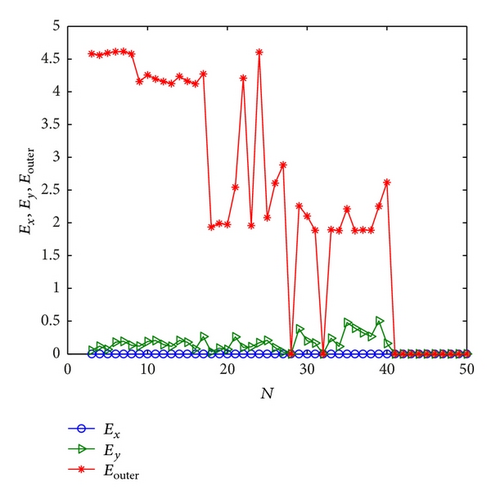
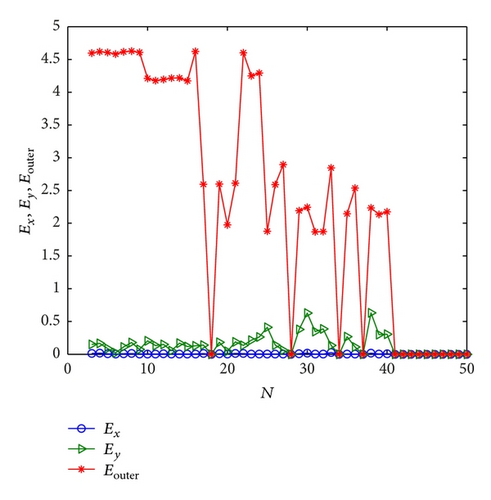
4. Conclusions
The current study investigated the synchronization between two discrete-time networks with mutual couplings and mainly studied inner synchronization inside each network and outer synchronization between them. We then obtained a synchronous theorem on the inner synchronization inside each network in terms of linear matrix inequality, for the lack of a criterion on the outer synchronization. When the inner synchronization is achieved inside each network and the synchronized states xs and ys are same for a large time, then the outer synchronization will happen. From the numerical simulations, we see that the inner and outer synchronization simultaneously happen when we adjust the values of coupling strengths and parameters in the node dynamics. The globally connected and random topologies have similar effect on the inner and outer synchronization. In addition, outer synchronization is more difficult to achieve than the inner synchronization, meaning that the outer synchronization needs a strong coupling form. Because of the diversity of coupling forms between two networks, deriving the criteria on the inner and outer synchronization simultaneously is a technical challenge, which would be discussed in the future.
Conflict of Interests
The authors declare that there is no conflict of interests regarding the publication of this paper.
Acknowledgments
This work was supported by the National Natural Science Foundation of China (nos. 61203155 and 11171084) and Zhejiang Provincial Natural Science Foundation of China under Grant no. LQ12F03003.




